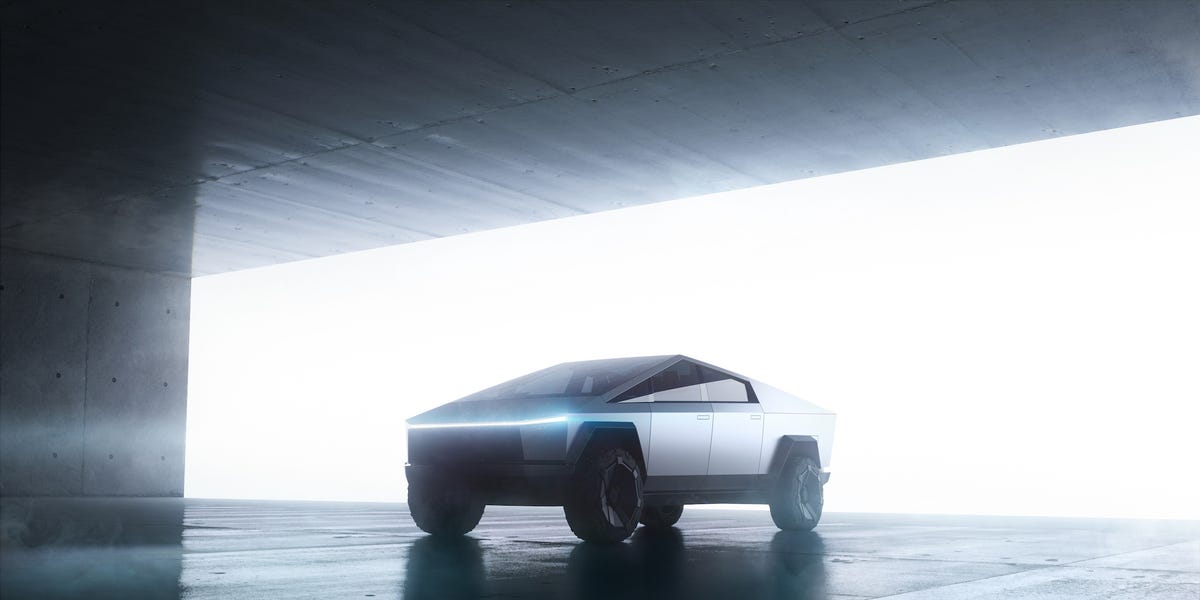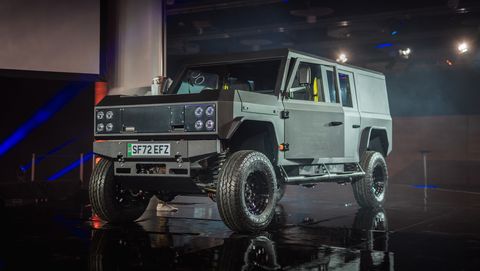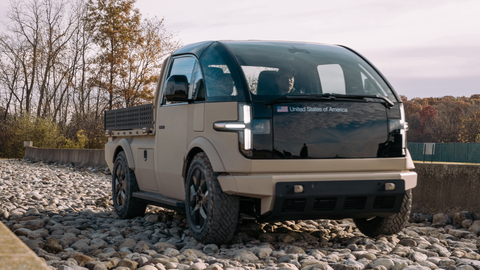
The meteoric rise of Tesla in the 2010s—as well as the relative simplicity of electric powertrains—has inspired countless entrepreneurs to try their hand at starting trendy, forward-thinking car companies. Many of these have already come and gone, their renderings and outlandish claims collecting dust in a forgotten corner of the internet, while many more cling on as they navigate the myriad challenges that come with mass-producing a car. Meanwhile, the EV market has grown incredibly crowded, so we decided to break down what happened—and didn’t happen—in the world of automotive startups in 2022.
Tesla Cybertruck
Tesla has finally brought its electric Semi to market, delivering the first units to PepsiCo in December, but the Cybertruck remains missing in action. The radical pickup’s original launch date of late 2021 was rescheduled to 2022 before Elon Musk admitted last January that the Cybertruck—along with the revived Roadster—will yet again be pushed back.
But last spring, a leaked video showing a Cybertruck prototype whipped the Tesla faithful into a frenzy, and Musk promised in April at the opening of the new Giga Texas factory that the Cybertruck would enter production in 2023. Even if that happens, it is unclear how closely the roadgoing model will match the original concept, since Musk has publicly questioned “the average cost of a Cybertruck and to what degree is that affordable.”
2022 also saw Musk controversially purchase Twitter, subsequently sending Tesla’s stock spiraling. Given Musk’s track record of overpromising and underdelivering, we wouldn’t be shocked to learn of another delay for the the wedge-shaped EV truck in 2023. Still, we got an exclusive sneak peek at the Cybertruck when we drove one in June . . . just kidding.
Deus Vayanne
The world of hypercars has always celebrated obscure companies making unbelievable claims, but the democratization of power heralded by EVs has exponentially increased the number of automakers seeking to enter the realm of high-performance land missiles. The 2022 New York auto show saw the introduction of the Vayanne, the first proposed vehicle from Austria-based startup Deus Automobiles.
Not slated to arrive until 2025, the Vayanne allegedly makes 2200 horsepower and 1475 pound-feet of torque, which Deus claims will shoot the car to 62 mph in under 1.99 seconds before maxing out at 248 mph. But the company mysteriously omitted any details on the powertrain, and the static model we sat in on the show floor felt cheap and unfinished.
Deus will have help from established players—Italdesign penned the Vayanne’s slinky lines, while Williams Advanced Engineering has been recruited to hone the technical bits—but we’re still skeptical that we’ll ever see the Vayanne move under its own power.
Faraday Future FF 91
Nearly six years had passed since we had heard about Faraday Future, a California-based startup that revealed its electric FF 91 crossover at the 2017 CES tech show that was formerly known as the Consumer Electronics Show. But the company reared its head again this year when it proclaimed in February that the FF 91 would enter production in the third quarter of 2022.
Faraday Future, which has faced a litany of financial troubles since its inception, missed that goal, revealing in July that it would need significant investment not only to launch the FF 91 but also to continue operations through the end of the year.
The startup pressed on, however, earning a 381-mile range estimate from the EPA in September for the flagship FF 91 Futurist model, which uses a 142.0-kWh battery. In December, Faraday Future announced that March 2023 is the new targeted start date for production of its 1050-hp crossover, but that is dependent on the arrival of more funding. Given the company’s rocky past, we remain wary.
Drako Dragon
The Dragon super-SUV is the second product from San Jose–based Drako Motors, packing four electric motors that combine for a colossal 2000 horsepower. With all-wheel drive and despite a nearly 5000-pound curb weight, Drako claims, the muscular SUV can reach 60 mph in 1.9 seconds and a top speed over 200 mph, and can sprint a quarter-mile in just 9.0 seconds.
However, there’s not much evidence that the company ever delivered on its first model, the Fisker Karma–based GTE, which produced 1200 horsepower and cost $1.3 million. When Drako first teased the Dragon, the company vaguely told us it is currently “in full swing building and delivering [the] GTE to customers and investment partners.”
Yet only one GTE has ever been photographed: the red example revealed at the Pebble Beach Concours d’Elegance in 2019. And while Drako still has a few years until the Dragon’s scheduled launch in 2026, the company’s unverified production history and the Dragon’s fantasy-land specs don’t boost our confidence that it will ever see reality.
Munro EV
The Munro Mk1 EV, revealed in early December, takes up the mantle for squared-off, back-to-basics off-roading EVs from Bollinger Motors, after the American startup canceled plans to produce the rugged B1 SUV and B2 pickup to focus on vans instead. The Munro, which hails from Scotland, is actually designed by the same man who used a ruler to draw Bollinger’s boxes, although the Mk1 somehow looks even more like a kit car cobbled together in someone’s shed.
Focused on commercial sales, the Munro will be classified as a Class 3 medium-duty truck in the United States, with the ability to tow up to 7700 pounds and carry up to 2200 pounds of cargo. The Mk1’s 375-hp maximum output is surprisingly reasonable by startup standards, but with only up to 81.0 kWh worth of battery and at least 5500 pounds to move, less than 200 miles of range is expected.
Although Munro is still working on finding investors, the company claims limited production will start in 2023. But with a paltry range, unproven capability, and a price ranging from $61,000 to $115,000 for the amateur-looking design, we’d be surprised to see the Munro EV catch on.
Foxconn
An EV from tech juggernaut Apple has been rumored for nearly a decade, but it might be beaten to the punch by Foxconn, a Taiwanese firm that assembles the iPhone, among other products. In October Foxconn unveiled its first model, the Foxtron Model B, as it launches a joint venture with Yulon Motor, Taiwan’s largest car manufacturer.
The Model B—a hatchback styled by Italian design expert Pininfarina—is supposed to enter production in China in 2023, with the goal of eventually selling the EV in the United States. Little is known about the Model B’s specifications, but Foxconn has a head start on other startups after it purchased a plant in Lordstown, Ohio, in 2022.
Foxconn will build the Lordstown Endurance and the Fisker Pear under contract at the Ohio factory, previously owned by Lordstown Motors, and the Model B could eventually join that production line. While things look hopeful for Foxconn, the Taiwanese company’s long-term automotive prospects, especially for the U.S. market, remain cloudy.
Canoo
American startup Canoo first showed its podlike Lifestyle Vehicle in 2019, following it up with the boxy MPDV van in 2020 and a unique pickup truck in 2021. Production of the Lifestyle Vehicle was initially slated for 2021 before being delayed. Despite financial woes in May, the company insisted that production was still planned to start at its Arkansas plant this year.
Clearly, Canoo failed to reach that goal, with 2023 almost upon us and the company now shifting its attention to beginning production by the end of next year. Still, Canoo managed to make headlines in 2022 with several new partnerships, showing that interest in its distinctive EVs remains high.
In April, NASA chose the Lifestyle Vehicle to transport crew at the launch site for its Artemis expedition, which aims to land humans on the moon in 2025 for the first time since 1972. In July, Canoo announced that Walmart will buy 4500 delivery-spec Lifestyle Vehicles, with the retail giant already testing vehicles, and December saw the U.S. Army receive a pickup for evaluation. Canoo still needs to figure out how to start production, but the increased interest in its products bodes well for 2023.
Indi One EV
Along with the bedroom-poster-worthy Deus Vayanne, the New York auto show gave us a chance to check out the Indi One EV, an electric crossover from an obscure California-based startup founded in 2017. At the show, Indi EV proclaimed that it would start production in mid-2023, and in October Indi EV signed an agreement with—you guessed it—Foxconn to build prototypes at the plant in Lordstown, Ohio.
The One is not meant to be a sports car. The standard version will hit 60 mph in a claimed 6.7 seconds with a 230-mile range, while the top trim will add 70 miles and shave 2.5 seconds off the 60-mph sprint. Instead, the main focus of the One is its immense computing power, which Indi says will allow for high-quality video streaming and gaming from inside the vehicle.
The prototype seen in New York did not look production-ready, and the company’s pricing—between $45,000 and $69,000—is ambitious. At the show, the company’s head of product deisgn, Andre Hudson, presented the One, but since then he has already abandoned ship for a different startup, Mullen Automotive. We’re not confident Indi EV will make it, but we’re always happy to be surprised.
Honorable Mentions
Nikola, whose infamous founder, Trevor Milton, was found guilty of fraud charges in October, pivoted away from the planned Badger pickup in late 2021 and spent 2022 building the electric Tre semi truck and developing a hydrogen-fuel-cell version.
Bollinger also shifted its focus away from its consumer pickup to a cab-forward electric Class 4 truck called the B4, aiming for production in late 2023. Mullen Automotive—another startup peddling its own electric SUV called the Five and a sports car called the Dragonfly (a rebadged version of the Qiantu K50 sold in China)—purchased a majority stake in Bollinger and bought the assets for the EV vans developed by the bankrupt Electric Last Mile Solutions.
Swedish company Volta also expanded its lineup of Zero delivery trucks as it prepares to start production in 2023, while U.K.-based Arrival struggled to meet production targets in 2022 before building its first prototype in September.
Success Stories?
While we wouldn’t yet classify these companies as successes, several startups built their first road-worthy cars in 2022. After years of uncertainty, the first customer-bound Lordstown Endurance trucks began rolling off the line in Ohio in November, and we drove an early-production example in October.
Fisker also kicked off production of its electric Ocean SUV in November, with Magna Steyr assembling the vehicles in Austria ahead of deliveries early next year. Fisker also teased two upcoming models, a smaller crossover called the Pear that is supposed to cost less than $30,000 and a sultry sports car called the Ronin that’s due in 2024.
While VinFast has been selling cars in Vietnam since 2019, the company’s expansion to the U.S. with its VF8 and VF9 crossovers was due to start in late 2022. Last week VinFast announced that the ship carrying the first U.S.-spec vehicles had reached California and promised to begin deliveries before the year’s end.
This content is imported from OpenWeb. You may be able to find the same content in another format, or you may be able to find more information, at their web site.
















